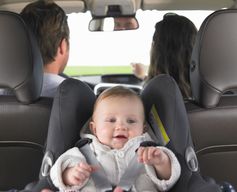Stage 1The first stage is a rear facing bucket seat for newborns weighing 4lbs and up. Bucket seats are designed to keep your baby reclined at a 45 degree angle to make it easier for them to breathe. A base is installed in the back seat of the car and the seat itself can be removed. Be sure to follow instructions for proper installations, and if you're not sure if the seat is properly secured, don't hesitate to check with a specialist. The height and weight limitations of bucket seats vary by manufacturer. While regulations vary from province to province, a good practice is to keep your child in a bucket seat until they weigh a minimum of 20lbs, are over 1 year old and can walk unassisted. Stage 2 At stage two it's typical to move up to a front facing seat with a 5 point harness that keeps your child sitting up properly while snugly strapped in. At this point regulations allow for front facing seats, however many manufacturers go above and beyond the recommendations and design seats that can be installed as front or rear facing. These are known as convertible seats and they make it possible to keep your child in a rear facing seat for longer. While rear facing seats are not mandatory, this design has been proven to reduce child injury and death, and kids as old as 6 can sit in them comfortably. Stage 3 The purpose of a booster seat is to allow older children to properly use the car seatbelt. Designed for older children, booster seats must still be installed in the back of your vehicles, away from the front airbags that can severely injure or kill a child. Some booster seats will have a full back to protect the neck and head and some will only have a cushion to boost the child so that the seatbelt can lie properly across their hips and shoulder. You should consider opting for the full back booster seat if the headrest in your vehicle cannot be adjusted to support your child's head. Stage 4At this stage, children can graduate to using a regular seat and seatbelt. To check if your child is ready, have them sit all the way back and clip in the seat belt. The belt must sit straight across the hips, and the shoulder strap must fit over the top of the shoulder, without touching the neck. Their knees should bend comfortably over the edge of the seat, and they shouldn't have to slide down to get comfortable. At every stage be mindful of the manufacturer's size and weight limitations and don't use the seat once your child outgrows it. Follow manufacturer's guidelines to ensure proper installation and safe restraint of your child's position in the seat.
2 Comments
Your vehicle is a big investment. We protect it from physical damage, but you can do your part too.
1. Keep your vehicle locked at all times. If your vehicle is open, thieves have easy access to anything that may be in the vehicle. 2. Never leave the keys in the vehicle, even if you're warming it up in the winter. Leaving keys in an unattended vehicle makes it a target for thieves. Consider purchasing an auto-start system and keep it locked while in use. 3. Don't leave valuables in plain view. Leaving a laptop or large sums of cash in plain sight makes your vehicle a target for theft and vandalism. 4. Install an anti-theft device. There are many types of anti-theft devices. They can be steering wheel locks, hood locks, tire locks, electronic immobilizers, or kill switches. 5. Park in a garage or well-lit area. Well-lit areas provide more opportunity for thieves to be noticed and caught. Garages can be locked and add a second layer of security. 6. If they can't drive it, they can't steal it: Manual Transmission Theory. Less and less people are learning to drive manual transmissions every year. If a thief can't drive a standard, they can't steal your car. 7. Close the windows. It's very easy to steal something from a vehicle with the windows down. Even having the windows down a little bit can give a thief the opportunity to reach in and unlock the door. 8. Park with your wheels turned to the curb. Rather than breaking and entering, some thieves might choose to tow your vehicle away. If you park with the wheels turned towards the curb, the vehicle is much harder to tow. |
Contact Us(506) 466-3330 Archives
April 2021
Categories
All
|
Navigation |
Connect With UsShare This Page |
Contact UsDay Insurance
78 Milltown Blvd. St. Stephen, New Brunswick E3L 1G6 (506) 466-3330 Click Here to Email Us |
Location |
Website by InsuranceSplash



 RSS Feed
RSS Feed